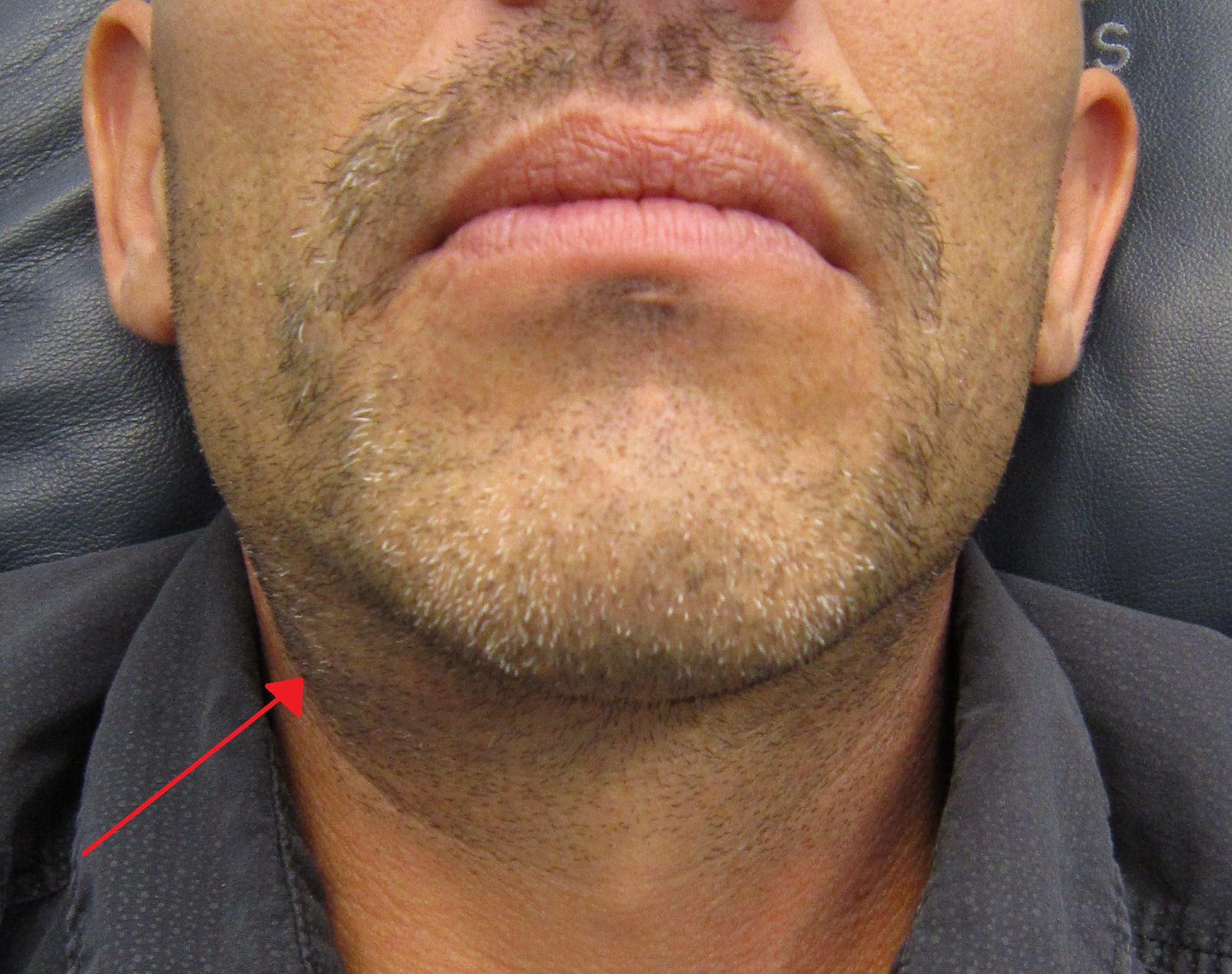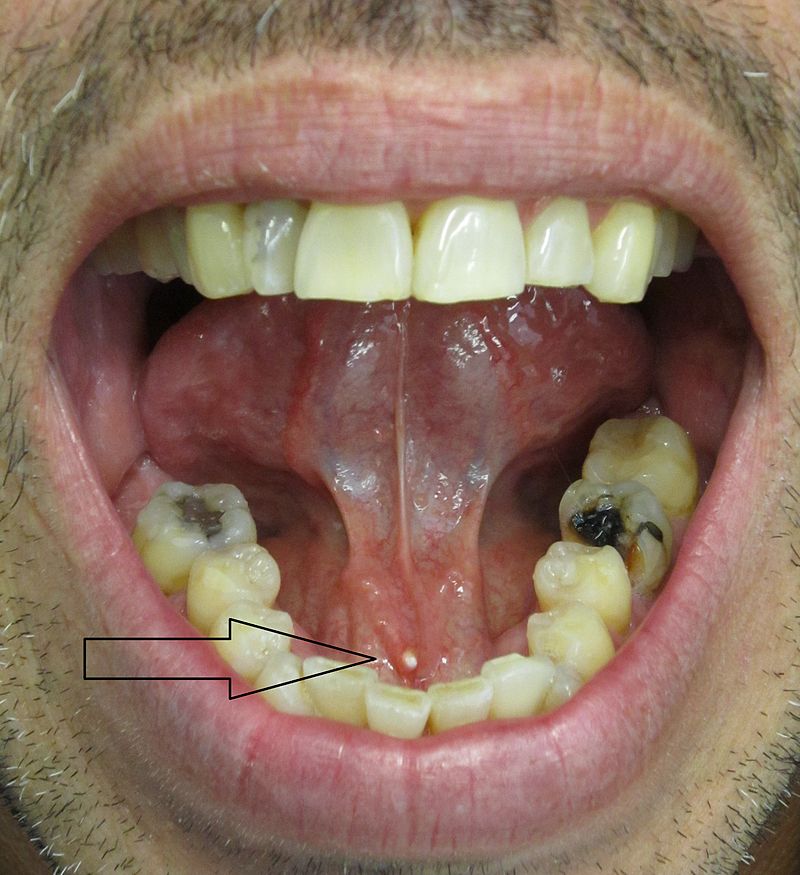Sialolithiasis physical examination: Difference between revisions
No edit summary |
m (Bot: Removing from Primary care) |
||
| (21 intermediate revisions by 3 users not shown) | |||
| Line 1: | Line 1: | ||
__NOTOC__ | __NOTOC__ | ||
{{ | {{Sialolithiasis}} | ||
{{CMG}}; {{AE}} | {{CMG}}; {{AE}} {{MA}} | ||
==Overview== | ==Overview== | ||
Patients with | Patients with sialolithiasis usually appear normal. Physical examination of patients with [[sialolithiasis]] is usually remarkable for [[tenderness]] of the involved gland, palpable hard [[lump]] and [[pus]] discharging from the duct in cases of acute bacterial [[sialadenitis]]. | ||
==Physical Examination== | ==Physical Examination== | ||
Physical examination of patients with sialolithiasis is usually remarkable for: [[tenderness]] of the involved gland, [[palpable]] hard [[lump]] and pus discharging from the duct in cases of acute bacterial [[sialadenitis]]. | |||
===Appearance of the Patient=== | ===Appearance of the Patient=== | ||
*Patients with sialolithiasis usually appear normal | *Patients with sialolithiasis usually appear normal. | ||
{| align="right" | |||
|[[image:Swelling of the submandibular gland.jpeg|thumb|300px|Swelling of the submandibular gland, By James Heilman, MD- via wikimediaCommons<ref><"//commons.wikimedia.org/wiki/User:Jmh649" class="mw-redirect" title="User:Jmh649">, <"https://creativecommons.org/licenses/by-sa/3.0" title="Creative Commons Attribution-Share Alike 3.0">CC BY-SA 3.0, <"https://commons.wikimedia.org/w/index.php?curid=24076831"></ref>]] | |||
|- | | |||
|[[image:Salivary stone in submandibular salivary duct.jpg|thumb|300px|Salivary stone in submandibular salivary duct, By James Heilman, MD- via wikimediaCommons<ref><"//commons.wikimedia.org/wiki/User:Jmh649" class="mw-redirect" title="User:Jmh649"><"https://creativecommons.org/licenses/by-sa/3.0" title="Creative Commons Attribution-Share Alike 3.0">CC BY-SA 3.0, <"https://commons.wikimedia.org/w/index.php?curid=24076829"></ref>]] | |||
|} | |||
===Vital Signs=== | ===Vital Signs=== | ||
| Line 37: | Line 24: | ||
===HEENT=== | ===HEENT=== | ||
Normal [[salivary gland]] is spongy. | |||
In sialolithiasis:<ref name=":0">{{cite book | last = Hupp | first = James | title = Contemporary oral and maxillofacial surgery | publisher = Mosby Elsevier | location = St. Louis, Mo | year = 2008 | isbn = 9780323049030 }}</ref><ref>{{cite book | last = Neville | first = Brad | title = Oral & maxillofacial pathology | publisher = W.B. Saunders | location = Philadelphia | year = 2002 | isbn = 0721690033 }}</ref> | |||
* | * [[Tenderness]] of the involved gland. | ||
* [[Palpable]] hard lump near the end of the involved duct or under the tongue in submandibular duct stone. | |||
* [[ | ** Stones, sometimes may be felt smooth or irregular. | ||
* | * In total obstruction, no saliva is coming from the duct. | ||
* | * [[Erythema]] of the floor of the mouth in sialadenitis as a complication of sialolithiasis. | ||
* [[Pus]] discharging from the duct in cases of infection of salivary gland ( acute bacterial sialadenitis). | |||
* | * Stone in the minor salivary glands can be felt as a small [[Nodule (medicine)|nodule]]. | ||
* Stones are typically rock hard and small; they may be smooth or irregular. They are most commonly felt within the ductal system. | |||
*[[ | |||
* [[ | |||
* | |||
* | |||
===Neck=== | ===Neck=== | ||
* | * Cervical [[lymphadenopathy]] in the cases of infection | ||
===Lungs=== | ===Lungs=== | ||
* Pulmonary examination of patients with | * Pulmonary examination of patients with sialolithiasis is usually normal. | ||
===Heart=== | ===Heart=== | ||
* Cardiovascular examination of patients with | * Cardiovascular examination of patients with sialolithiasis is usually normal. | ||
===Abdomen=== | ===Abdomen=== | ||
Abdominal examination of patients with | Abdominal examination of patients with sialolithiasis is usually normal. | ||
===Back=== | ===Back=== | ||
* Back examination of patients with | * Back examination of patients with sialolithiasis is usually normal. | ||
===Genitourinary=== | ===Genitourinary=== | ||
* Genitourinary examination of patients with | * Genitourinary examination of patients with sialolithiasis is usually normal. | ||
===Neuromuscular=== | ===Neuromuscular=== | ||
* Neuromuscular examination of patients with | * Neuromuscular examination of patients with sialolithiasis is usually normal. | ||
===Extremities=== | ===Extremities=== | ||
* Extremities examination of patients with | * Extremities examination of patients with sialolithiasis is usually normal. | ||
==References== | ==References== | ||
{{Reflist|2}} | {{Reflist|2}} | ||
| Line 155: | Line 64: | ||
{{WH}} | {{WH}} | ||
{{WS}} | {{WS}} | ||
[[Category:Medicine]] | [[Category:Medicine]] | ||
[[Category:Gastroenterology]] | [[Category:Gastroenterology]] | ||
[[Category:Up-To-Date]] | [[Category:Up-To-Date]] | ||
Latest revision as of 00:10, 30 July 2020
|
Sialolithiasis Microchapters |
|
Diagnosis |
|---|
|
Treatment |
|
Case Studies |
|
Sialolithiasis physical examination On the Web |
|
American Roentgen Ray Society Images of Sialolithiasis physical examination |
|
Risk calculators and risk factors for Sialolithiasis physical examination |
Editor-In-Chief: C. Michael Gibson, M.S., M.D. [1]; Associate Editor(s)-in-Chief: Mahda Alihashemi M.D. [2]
Overview
Patients with sialolithiasis usually appear normal. Physical examination of patients with sialolithiasis is usually remarkable for tenderness of the involved gland, palpable hard lump and pus discharging from the duct in cases of acute bacterial sialadenitis.
Physical Examination
Physical examination of patients with sialolithiasis is usually remarkable for: tenderness of the involved gland, palpable hard lump and pus discharging from the duct in cases of acute bacterial sialadenitis.
Appearance of the Patient
- Patients with sialolithiasis usually appear normal.
 |
 |
Vital Signs
- Vital signs are usually normal but low grade fever may be seen in sialadenititis as a complication of sialolithiasis.[3]
Skin
- Skin examination of patients with sialolithiasis is usually normal.
HEENT
Normal salivary gland is spongy.
- Tenderness of the involved gland.
- Palpable hard lump near the end of the involved duct or under the tongue in submandibular duct stone.
- Stones, sometimes may be felt smooth or irregular.
- In total obstruction, no saliva is coming from the duct.
- Erythema of the floor of the mouth in sialadenitis as a complication of sialolithiasis.
- Pus discharging from the duct in cases of infection of salivary gland ( acute bacterial sialadenitis).
- Stone in the minor salivary glands can be felt as a small nodule.
- Stones are typically rock hard and small; they may be smooth or irregular. They are most commonly felt within the ductal system.
Neck
- Cervical lymphadenopathy in the cases of infection
Lungs
- Pulmonary examination of patients with sialolithiasis is usually normal.
Heart
- Cardiovascular examination of patients with sialolithiasis is usually normal.
Abdomen
Abdominal examination of patients with sialolithiasis is usually normal.
Back
- Back examination of patients with sialolithiasis is usually normal.
Genitourinary
- Genitourinary examination of patients with sialolithiasis is usually normal.
Neuromuscular
- Neuromuscular examination of patients with sialolithiasis is usually normal.
Extremities
- Extremities examination of patients with sialolithiasis is usually normal.
References
- ↑ <"//commons.wikimedia.org/wiki/User:Jmh649" class="mw-redirect" title="User:Jmh649">, <"https://creativecommons.org/licenses/by-sa/3.0" title="Creative Commons Attribution-Share Alike 3.0">CC BY-SA 3.0, <"https://commons.wikimedia.org/w/index.php?curid=24076831">
- ↑ <"//commons.wikimedia.org/wiki/User:Jmh649" class="mw-redirect" title="User:Jmh649"><"https://creativecommons.org/licenses/by-sa/3.0" title="Creative Commons Attribution-Share Alike 3.0">CC BY-SA 3.0, <"https://commons.wikimedia.org/w/index.php?curid=24076829">
- ↑ McKenna JP, Bostock DJ, McMenamin PG (1987). "Sialolithiasis". Am Fam Physician. 36 (5): 119–25. PMID 3318353.
- ↑ Hupp, James (2008). Contemporary oral and maxillofacial surgery. St. Louis, Mo: Mosby Elsevier. ISBN 9780323049030.
- ↑ Neville, Brad (2002). Oral & maxillofacial pathology. Philadelphia: W.B. Saunders. ISBN 0721690033.